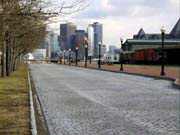Members of the Jersey City Landmarks Conservancy (JCLC) will meet with Public Works Director Betty Outlaw to discuss the future of a cobblestone section of Provost Street that was accidentally paved over in November.
While the paving was technically legal since Provost Street is not on the city’s register of historic places, both conservationists and city officials agree that it is important to preserve the five cobblestone streets that remain throughout the city.
“Cobblestone streets conjure up an age long forgotten, long gone: 19th century Jersey City,” said JCLC President John Gomez. “They beautify the landscape and add value to the neighborhood. People want to walk along smooth glistening stones.”
A piece of history
According to Gomez, the cobblestone section of Provost Street, located in the Powerhouse District between Second and Morgan streets, is unique because it is made of marble rather than basalt and granite. Built in 1890, the stone beds contain remnants of rail tracks.
“Provost Street is the only remainder of the unique, ornamental street fabric that traversed the district,” Gomez said.
If the street had been registered, paving or any proposed alterations would have to be reviewed by the Jersey City Historic Preservation Commission in City Hall.
“Municipal government is not usually in the business of preservation,” said Gomez. “and it most certainly isn’t going around taking an inventory of historic objects like cobblestone streets. Provost Street fell victim to blindness, neglect, obscurity. It’s no surprise this happened.”
Stan Eason, spokesperson for Mayor Glenn Cunningham, said that the mayor is committed to protecting the city’s historic sites. “It adds a sense of appreciation for our history and the historic character of Jersey City, which has a rich historical background,” Eason said.
According to Jersey City Historic Preservation Officer Dan Wrieden, none of the streets have been registered to the Municipal Register of Historic Places as of last week.
Sites can also be registered with the State Register of Historic Places, and the National Register of Historic Places, each offering a higher level of protection and preservation grants.
“Typically, the owner of a historic building, site, or object applies for the designation,” said Gomez. “But more and more outside entities are stepping in, namely because owners are neglecting the very history they own. In the case of Provost Street, it is owned, like most public streets, by the city of Jersey City.”
According Eason, Outlaw is expected to take the initiative in registering the streets.
If the city proceeds in restoring the street, the DPW will have to hire an outside contractor to take up the asphalt, as it is now a specialty restoration job.
The matter is complicated by the fact that the once the streets are protected, they must remain drivable, requiring specialized maintenance.
“Over time they do deteriorate,” said Eason, “and we have to maintain them. There are experts in historical preservation that are required to do this kind of job, and there are special grants available that we are pursuing.”
Gomez said Jersey City history is typically protected through volunteer groups such as the JCLC, Friends of the Loews, the Embankment Preservation Coalition, the Jersey City Reservoir Preservation Alliance, and various neighborhood associations.
“If the application process were easier and not so embroiled in politics and bureaucracy, there would be a lot more landmarking going on,” Gomez said.
The other cobblestone streets
The other cobblestone streets are scattered throughout the city.
Holland Street, an old cobblestone carriage road, winds down the cliff side from Palisades Avenue in the Heights to Paterson Plank Road. It was put on the Municipal Register last year.
“After months of historical research, red tape, meetings, and lobbying, we obtained landmark status,” said Gomez. “Which essentially put the brakes on previous plans by the city and county to take up the cobbles.”
Neighborhood associations such as the Riverview Neighborhood Association, Save the Palisades, and the JCLC hold clean-ups twice a year.
Audrey Zapp Drive, located in Liberty State Park, is thought to be the oldest cobblestone road in the country. The other cobblestone streets are Manning Avenue between Lafayette Street and Communipaw Avenue and 17th Street at the Lackawanna Terminal Viaduct, which is at Grove Street and Washington Boulevard.
The five year old JCLC consists of a nine-person board and nine advisors. They hope to launch a membership drive during May’s Preservation Week.
Gomez said, “JCLC maintains large e-mail and mailing lists, built up over five years, which enables us to reach our preservation support base.”
